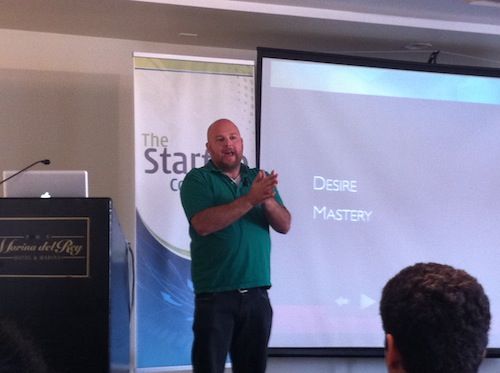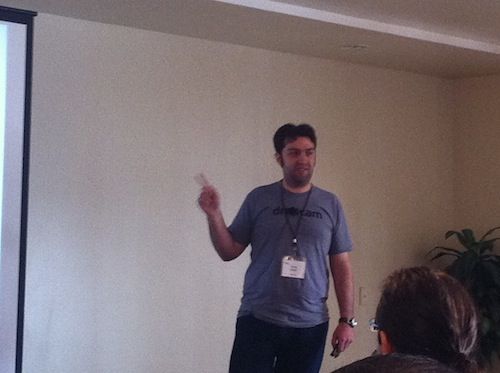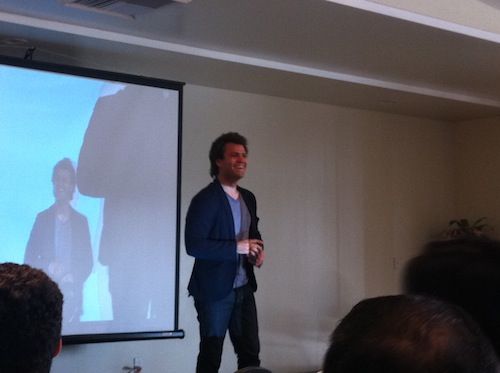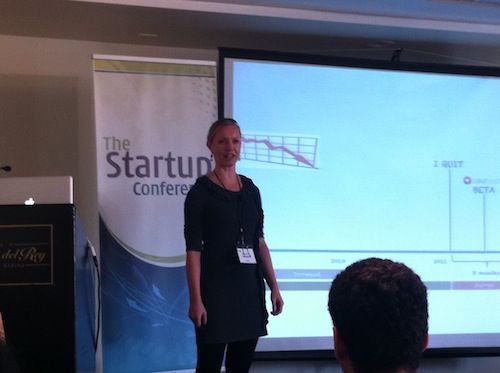The exciting day of startup wisdom continued at the Startup Conference LA with Gave Zichermann who discussed Gamification for Startups. Gabe is the chair of the Gamification Summit and Workshops, and is the co-author of the book “Game-Based Marketing.”

Gamification is the process of using game concepts and mechanics to engage users. Gamification is not just throwing some badges up on your website, it’s more than that – you need to really engage your users. Make sure your game makes sense for the audience – Zombie Nazi’s are probably not the best fit for a startup focused on finding oil change locations near you.
Premal Shah, founder of Kiva said their biggest competitor is Zynga, not because of the products Zynga makes but because of the focus they are getting. In Sweden the price of the ticket is not dependent on your speed but instead how much money you make, in fact they just gave-out at $250,000 ticket (true story!). One guy game-up with a cool idea around gamification of speed cameras by entering people in a lottery to win money if they pass the camera at or below the speed limit, and it worked – reduced speeding by 20%! This shows how small, short-cycle positive gamification can produce real results.
Car companies are already taking-part in gamification when it comes to hybrid cars. Center console showing how efficiently the car is running and turning this into an interactive game, i.e. a leaf that gets more green and lush with the more efficiently you are driving. This is absolutely unnecessary since someone has already purchased the car but it makes people happy and every day makes them feel f*@king good they bought the car.
Introducing game mechanics into your company can reward employees for positive behavior. Be careful not to reward altruistic behavior with cash, try using something like karma points, otherwise you put a price on altruism.
Next up was Greg Duffy giving a talk titled – “Don’t be a wimp – build something hard.” Greg is the founder and CEO of Dropcam, an innovative Internet camera solution accessible from iPhones, Android devices, and computers.

Greg started-out by talking about the concept of getting users. He started by making an excellent point – getting a million users is much easier than getting a million dollars. This is one of the challenges with the freemium model – you might be able to get a ton of people using your products, but how do you make money?
If your business makes money from advertising then your users are not your customers, your advertisers are.
Greg covered a lot of ground in his talk and brought it all together in the end:
• Ask yourself if you’re playing the startup lottery
• Ruby-on-rails web startups or singular iPhone apps are almost never moats
• Instead build something hard
• If you do it in a big market people will pay big bucks
• Your investors and co-founders will thank you
Next up was Zach James, the cofounder of MovieClips.com talking about the Entrepreneur’s Journey. MovieClips.com recently raised 12 million in capital and is the fastest growing channel on You Tube. Before starting his business Zach worked as an investment banker but learned that to make the leap he had to quit his job.
The only way to get ahead in life is equity. The difference between calling yourself and entrepreneur and feeling like an entrepreneur is when you have everything on the line. You have to be afraid and be willing to lose everything. When you’re in this mode you’ll surprise yourself.
Work your first five years like nobody else can and live the rest of your life like nobody else will.

Zach raised 12.5 million dollars with no views, not money, just hype. He identified every single VC that he could and then sent them emails every single week to let them know what they were doing. Keeping things hot and relevant.
It is absolutely critical to talk to other entrepreneurs along the way. There are peaks and valleys in this business and it’s important to go through it together.
The last talk before lunch was one I was really looking forward to titled, “From Bootstrapped to TechCrunch,” by Rebecca Woodcock co-founder of Cake Health. You’ve probably heard of Cake Health as they recently launched at TechCrunch Disrupt just a few months ago. Rebecca shared her story leading-up to the TechCrunch launch.
In January of this year Rebecca quit her job and focused full-time on Cake Health. This meant living on savings and Rebecca actually was down to her last month of rent-money by the time the company went to Disrupt.
Early in the year Cake Health heard about another company doing something very similar to what they were doing. They found-out about this company since they tweeted that they applied to TechCrunch Distrupt (not a great idea!).

So Cake Health had to get an advantage. Their first advantage was to get their announcement out ahead of the competition and their second advantage was to heat up the space. Cake Health gave 500 invites to TechCrunch so they could have an exclusive on giving-out the first accounts. This created a waitlist of over 3,000 people since there was nice buzz about the company. When their competitors found-out about this they tried to copy Cake Health…but this just grew more awareness for Cake Health.
So with a waitlist of 5,000 what did they do next? The first month they fixed a bunch of bugs, then in the second month they started sending invites in batches of 200 and then let everyone in before TechCrunch Disrupt. Tip – waitlists get stale after three months, important to communicate with your waitlist even if you don’t have anything more to give them.
Pro tip – take care of those passionate enough to speak up. Anyone who tweeted or emailed Cake Health got an instant invite. Any critics were given attention and by taking care of them they became their biggest advocates.
TechCrunch Tips:
1. Get to the demo in less than 20 seconds
2. Sprinkle teasers for Q&A
When Cake Health launched their traffic increased by over 3000% and by mid-week they had already pulled-in over $8 million in claims. Now they are a funded company, and yes they are hiring!



